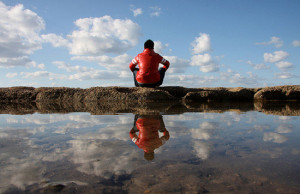 We had the second meeting of our four week Introduction to Meditation Class at Yoga Bliss yesterday. During the month of November we’re focusing on the basics in order to help each other build a personal practice.
We had the second meeting of our four week Introduction to Meditation Class at Yoga Bliss yesterday. During the month of November we’re focusing on the basics in order to help each other build a personal practice.
We began with a body scan and revisited the six points of posture. Bringing awareness to feeling sensation in the whole body and then different body parts helps to calm and center our minds. Body awareness also serves to activate areas of the brain’s right hemisphere that can help to quiet the internal “chatter” of the left hemisphere. We continued with a formal mindfulness meditation in which we focused our awareness on the breath. This is a simple instruction but not easy to follow.
When we became aware that we were thinking, we noted silently to ourselves, “thinking,” with a gentle, nonjudgmental attitude. Labeling thoughts during meditation practice can be a powerful support that reconnects us with the fresh, open, unbiased dimension of our mind. When we became aware of feeling states like anxiety, impatience or frustration we allowed the feelings to be there – with a sense of spaciousness around them. Touching experience lightly and then returning to the breath. Instructor and author, Dr. Rick Hanson, encourages meditation students to “let be, let go and let in.”
We practiced formal walking meditation: synchronizing our steps with breathing and moving in harmony with each other. We noticed the complex balancing act involved with simple walking, feeling the physical sensations of weight and movement. It was a fascinating way to balance awareness between our inner and outer experience.
We shared about our experience of practice in class and at home during the past week. We appreciated having a “beginner’s mind.” I discussed Rick Hanson’s idea of having a personal “neurological profile.” Each of us differs in our tendencies to focus, screen distraction and seek stimulation. It’s important to have a sense of where we begin so we can adapt our approach to how we cultivate stillness. I often think that the very act of pausing and stopping to be still is radical – we’re like salmon swimming upstream against a current of hyper-sensory stimulation and multi-tasking tools that are supposed to make life “easier.”
There are a variety of approaches to meditation – why not find the ones that will help us where we are today and begin to grow the “neuro-muscles” we need to sustain us in our swim upstream? Meditation instructor and author Jack Kornfield writes: “The point of mindfulness is not to get rid of thought but to learn to see thought skillfully.” I whole heartedly agree. This practice is so much about intimacy – coming to really know the “self” more clearly. I believe this yields deeper insight into our shared human nature. We can use approaches like “bare witnessing” of our experience. We can also use “cultivation” practices to build inner resilience so we are capable of being more present with our fellows.
Rick Hanson describes the experience of mindfulness as it grows with practice:
As mindful presence increases, there is a growing sense of being as the container of your everyday life, which holds the doing and the having of daily activities. You are being being. Doing and having no longer contain little moments of being; instead, being is increasingly the ongoing space through which ripples of doing and having come and go.
. . . This quality of abiding as awareness moves out into your life beyond time spent meditating. . .
With people, you become more settled into being fully there with them, more peacefully relaxed in awareness of them and you and what’s happening, less identified with pleasant or unpleasant reactions that arise, less caught up in the past or future or sense of needing to make something happen.
I wish us all lots of energy and success in our explorations of being this week! You can find this week’s homework and other resources that will help you with exploring your “neurological profile” and adapting your meditation practice at:
November Introduction to Meditation Class 2 Homework
